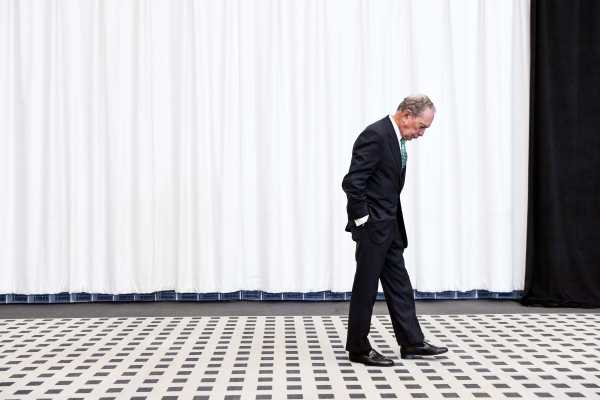
One of the first things Mike Bloomberg did as he prepared to run for president last year was apologize.
Even before announcing his run, Bloomberg, the former New York City mayor, was under fire for his embrace of stop and frisk, a policing strategy that disproportionately targeted minority communities and was later deemed unconstitutional. “I was wrong,” he said in November. “And I am sorry.”
That didn’t put the issue to rest.
Earlier this month, a 2015 video resurfaced in which Bloomberg defended stop and frisk in racist terms. In the video, he claimed “95 percent of murders, murderers, and murder victims” were “male minorities 16 to 25” and that one could “take the description, Xerox it, and pass it out to all cops.” He later added, “We put all the cops in minority neighborhoods. Yes, that’s true. Why do we do it? Because that’s where all the crime is. And the way you get guns out of the kids’ hands is to throw them up against the wall and frisk them.”
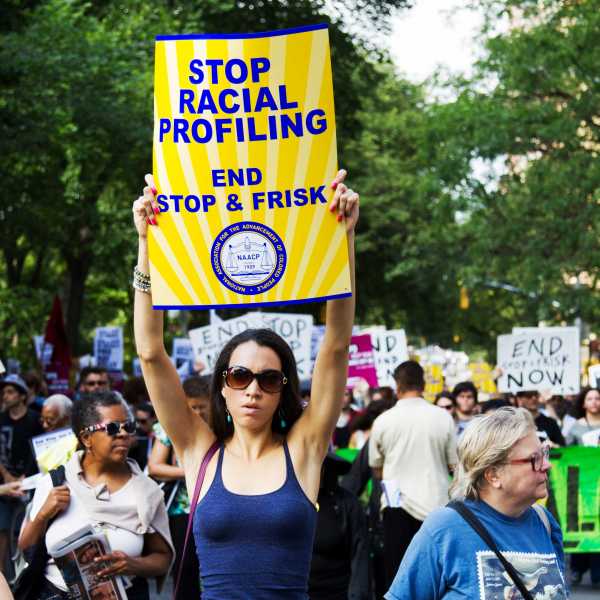
Bloomberg has since reiterated his apology on the campaign trail and debate stage. “There is one aspect of approach that I deeply regret, the abuse of police practice called stop and frisk,” he said this month. “I defended it, looking back, for too long because I didn’t understand then the unintended pain it was causing to young black and brown families and their kids. I should have acted sooner and faster to stop it. I didn’t, and for that, I apologize.”
Bloomberg’s policing strategy deployed officers to stop and frisk people, particularly in minority communities. The majority of people stopped — 80-plus percent — were people of color, typically young black or Latin men. The stops could be violent, with cops throwing kids against walls or the ground while shouting and cursing at them. Based on the research and New York City’s continued drop in crime after a significant reduction of stop and frisk, the approach did little to nothing to combat crime.
“Stop and frisk was this low-intensity warfare that people didn’t see unless they were right in it — unless you lived in those few blocks where people were constantly harassed,” Monifa Bandele, who’s on the steering committee for Communities United for Police Reform, told me. “Stop and frisk was killing our young people in a different kind of way — very deeply emotional, mental health, causing people to lose jobs, to be late to school. I called it the death by a thousand cuts.”
Stop and frisk was part of a much broader “broken windows” approach to policing, first adopted by Bloomberg’s predecessor, New York City Mayor Rudy Giuliani. Bloomberg continued and expanded Giuliani’s policies, not just through the greater use of stop and frisk but by emphasizing misdemeanor arrests, citing people for low-level offenses like jaywalking and open containers, and deploying more cops in schools, leading to more arrests particularly among students of color.
He also reformed some parts of the criminal justice system. Under his watch, the Rikers Island jail population continued to fall. His administration also oversaw probation reforms, and worked to end the incarceration of youth in state prison facilities, instead moving them closer to home or opting not to lock them up at all.
The mixed record speaks both to Bloomberg’s unorthodox tendencies — he ran for mayor as a Republican, then independent, and now is a registered Democrat — and to a management style in which he delegated tasks to a wide, diverse cast of people under him. And it reflects the rapid shifts in the criminal justice reform landscape, which began while he was in office and has led to many Democratic presidential candidates, including Joe Biden, Amy Klobuchar, and Kamala Harris, facing criticism in the past year for their “tough on crime” pasts.
Bloomberg’s campaign said that he reduced stop and frisk as mayor — although he only did that once legal challenges against stop and frisk seemed likely to win, and he continued defending stop and frisk even after he left office. The campaign also pointed to the criminal justice reforms he implemented as mayor, arguing “his long and impressive track record demonstrates his commitment to this issue.”
But his support and expansion of stop and frisk is a key part of his legacy — and puts him at odds with much of the modern Democratic Party in the era of Black Lives Matter. Whether and how he is able to overcome that legacy could define his path to the White House.
Stop and frisk was at the core of Bloomberg’s policing approach
When Bloomberg took office in 2002, crime remained one of the top concerns in New York City. It hadn’t been too long since the city in 1990 hit its peak for murders — with more than 2,000 in the city — and New Yorkers were fed up.
So Bloomberg embraced the “broken windows” philosophy — which argued that by policing even the lowest-level offenses, police could deter and stop all kinds of crime. Bloomberg, along with his police commissioner, Ray Kelly, massively expanded stop and frisk especially: In 2002, there were more than 97,000 reported stops. By 2011, that grew to nearly 686,000.
“As a New Yorker, I understood the visceral concern about crime. It was driving everything,” Vincent Schiraldi, who was the probation commissioner under Bloomberg from 2010 to 2014, told me. “One, he was super concerned about shootings and killings. And two, he really believed stop and frisk was an important component of reducing that. He definitely believed that stuff. No question. We used to argue about it.”
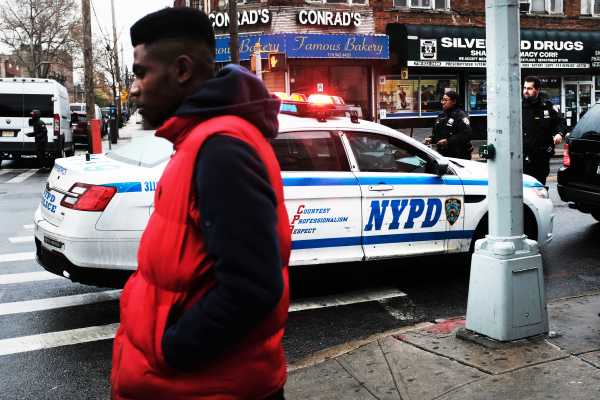
These stops were highly concentrated in minority communities: In 2011, for example, 53 percent of people stopped were black, and 34 percent were Latin, even though black and Latin people made up around 23 and 29 percent of the population, respectively. About 88 percent of the stops were of people that the New York Civil Liberties Union classified as innocent — meaning they led to no citations, summonses, arrests, or other police actions.
“Even if it’s just one stop, if you’re being stopped because you’re black, whether you were thrown up against the wall or spoken to politely, it’s traumatizing,” Bandele said, describing how black students at her daughter’s high school could be stopped, separated from the white peers they were walking with, and questioned on their way to class. “There’s a harm to racial profiling no matter how it’s done.”
These weren’t just police pat-downs. As Bloomberg implied in his comments about throwing kids against walls, police were often very aggressive. A common story was that cops would jump out of cars, round up entire groups of black and brown kids, curse at them, throw them against the wall or ground, and thoroughly frisk them — going under their clothes at times.
One teenager, identified only as Alvin, recorded one of the stops against him. The police were aggressive, never explained why they stopped him, and used racist language. When Alvin asked why he was being threatened with arrest, one officer said, “For being a fucking mutt.” Holding Alvin’s arm behind his back, a cop said, “Dude, I’m gonna break your fuckin’ arm, then I’m gonna punch you in the fuckin’ face.”
These kinds of stops happened hundreds of times a day, particularly in black and brown neighborhoods.
“‘Broken windows’ policing is a Giuliani-era approach to policing which has no consideration for any of the norms of justice and really demonizes and terrorizes communities of color,” Donna Lieberman, executive director of the NYCLU, told me. “I believe it’s either a corollary to or a product of — it doesn’t matter which — the war on drugs, which was set out as a war on people of color by the Nixon administration.”
Bloomberg characterized the policing of minority communities as necessary in the 2015 video, suggesting police only went to where the crime was. But that wasn’t true: Jeffrey Fagan, a law professor and criminal justice researcher at Columbia University, found that higher minority populations in a community “predict higher numbers of stops, controlling for the local crime rate and the social and economic characteristics of the precinct.” In other words, it was the demographic makeup of the neighborhood — not the rates of crime — that appeared to drive the stops.
The approach also didn’t appear to reduce crime much, if at all; studies found stop and frisk had weak to no effects, and crime in New York continued to drop after the police greatly reduced the use of the policy, beginning in 2012.
Bloomberg was still in office when stop and frisk was reduced in use. But the drop in stops was mainly in response to mounting legal challenges and a subsequent court ruling, which found stop and frisk, as implemented in New York City, was unconstitutional. In his last year as mayor, Bloomberg resisted the court ruling and the City Council’s attempts to reel back stop and frisk. And he defended stop and frisk after he left office in 2014, as evidenced by the recently resurfaced video from 2015.
Stop and frisk is one part of Bloomberg’s record
Stop and frisk was only one component of the broader “broken windows” approach. Under Bloomberg, police also went after lower-level offenses, including marijuana possession. The approach even extended to policing in schools, where kids were more likely to be cited and arrested under Bloomberg. There were racial disparities in these other actions too: Between October and December 2011, 94 percent of students arrested were black or Latin.
Some of these policies have remained in place even after Bloomberg. Despite pulling back, for example, stop and frisk as well as marijuana arrests, the current mayor, Bill de Blasio, has continued to embrace some “broken windows” tactics — which critics say led to the death of Eric Garner when police stopped him for allegedly selling untaxed cigarettes and put him in a chokehold.
“What replaced [stop and frisk] was the kind of thing that got Garner killed,” Fagan told me. “The police were making tens of thousands of misdemeanor arrests on ‘broken windows’ stuff — turnstile jumping, selling loose cigarettes, tens of thousands of arrests on the lowest-level misdemeanor charges — plus issuing citations for things like jaywalking, open containers, and the like.”
Separately, Bloomberg’s police department also conducted a wide-ranging surveillance program on Muslim communities — which, while not usually considered part of a “tough on crime” agenda, demonstrated his willingness to aggressively police minority communities.
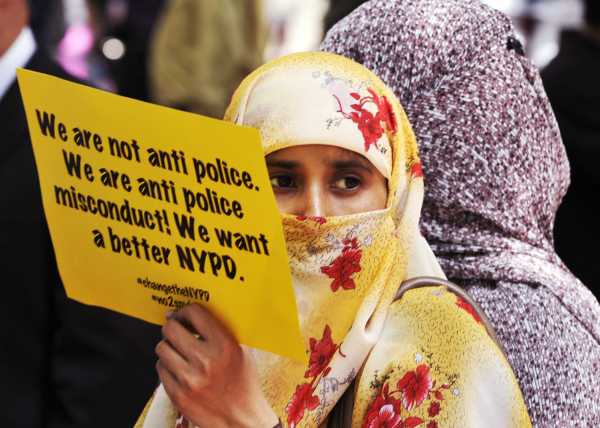
The punitive approaches fostered more distrust in police, particularly in communities of color. That could have led to more crime — if, as some research suggests, people took matters of the law into their own hands when they didn’t trust the police — or, at the very least, likely made cops’ jobs harder.
“The police rely on cooperation from the people that they’re supposed to protect in order to do their job,” Lieberman said. “When you lose that trust, people won’t talk to you. That’s a well-known phenomenon.”
Still, it’s true that crime continued to fall in New York City during Bloomberg’s tenure. The number of murders in New York City fell from nearly 600 in 2002 to less than 340 in 2014, the year after Bloomberg’s final term ended. That was a continued drop from the early 1990s, when murders hit more than 2,000 in the city.
What caused that massive drop? Fagan pointed to the city’s larger police force, arguing that the presence of more cops — though not necessarily their tactics — deterred some crime. The generation that grew up under the violent 1970s and ’80s also aged out of crime, and the new generations have been, for whatever reason, less predisposed to crime and violence. And the end of the crack cocaine epidemic of the 1980s and ’90s was a big contributor as well. (More broadly, crime and murder rates have plummeted across the country since the 1990s, and criminal justice experts point to all sorts of factors besides police for the nationwide crime decline.)
Bloomberg also implemented some criminal justice reforms. He embraced programs that diverted people, particularly those accused of low-level offenses, away from jail and prison. That helped continue the fall in the Rikers Island jail population; by 2014, the jail population dropped by half, to 11,000, from its 1991 peak. Under Schiraldi, Bloomberg’s Department of Probation also took steps to make probation less punitive — by penalizing fewer people for technical violations and by reducing probation terms. And Bloomberg helped put an end to the practice of locking up juveniles in state facilities, using the Close to Home program to move them, well, closer to home in New York City, if they were locked up at all.
The seeming contradiction between some criminal justice reforms and a “tough on crime” approach elsewhere may reflect Bloomberg’s management style. He tended to delegate major roles to his commissioners and other staffers, rarely micromanaging or getting involved on a daily basis outside some demands for data and evidence to support a new approach. As Schiraldi, who served under Bloomberg, put it, “He truly believed his people.”
Whatever the explanation, the result is at best a mixed record on criminal justice issues and at worst a collection of policies overwhelmed by a policing approach that terrorized people of color in New York City for more than a decade, all under Bloomberg.
The question for criminal justice reformers: Can they trust Bloomberg?
As he’s scaled up his presidential campaign, Bloomberg has apologized for stop and frisk, while putting out criminal justice reform plans that attempt to show he’s serious about reform.
Many of the reforms are very ambitious. He proposes setting up a hub in the Department of Justice that will evaluate and fund state-level reforms to cut incarceration by 50 percent by 2030. He calls for $2.5 billion over 10 years to boost public defense. He suggests ending cash bail. He wants to expand reentry services for formerly incarcerated people, including housing, mental health, and addiction treatment, and help kids whose parents are in prison.
In apologizing for stop and frisk, Bloomberg has cited his criminal justice reform proposals as evidence he’s trying to do better. “Let me make it clear, as president of the United States, I will work to dismantle systems that are plagued by bias and discrimination,” he said. “I will invest in the communities that [bore] the brunt of those systems for generations. And I’ll put this work at the very top of our agenda.”
Still, his proposals also expose some of his moderate roots. For one, Bloomberg only backs the decriminalization of marijuana, falling short of full legalization — a stance he explained by saying there’s a need for more research into cannabis. That puts him at odds with other Democratic candidates except Biden; the party has broadly shifted to backing legalization, and polls show more than 75 percent of Democrats support legalizing pot.
For criminal justice reformers, the question is if they can really trust Bloomberg. Can they believe that he’s come around to reform, after supporting a policy — stop and frisk — that helped lead to the rise of Black Lives Matter to begin with? And what message would his election send about reform efforts?
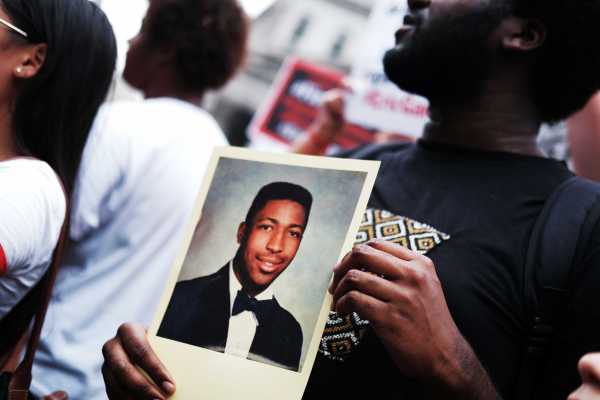
“I’m very concerned,” Bandele said. “By electing him, it almost takes those policies off the hook.”
The concern here isn’t just figuring out if Bloomberg is an honest person. A constant worry in criminal justice work is what would happen if the crime rate started to rise once again. In such a scenario, there would be considerably more pressure on lawmakers to go back to “tough on crime” rhetoric and policies — even if they are racist and, based on the research, ineffective for fighting crime in the first place.
It’s happened before. From the 1960s through the ’90s, crime and drug use were skyrocketing in the US. Especially in the early 1990s, Americans were much more likely to say that crime was the most important problem facing the country at the time. That drove lawmakers, both Democrats and Republicans, to try to find solutions that they could sell to the public — and they by and large landed on a more punitive criminal justice system.
Just how much all of this hurts Bloomberg remains to be seen. Various polls, including one from Vox and Morning Consult, have found the majority of Democrats support at least some criminal justice reform efforts. But other surveys, like Gallup’s, have also found that criminal justice issues aren’t too important for voters, falling behind concerns about the government and poor leadership, immigration, the economy, health care, and race relations.
But stop and frisk is a big enough part of Bloomberg’s legacy that he, at least, has already repeatedly apologized for it.
Sourse: vox.com






